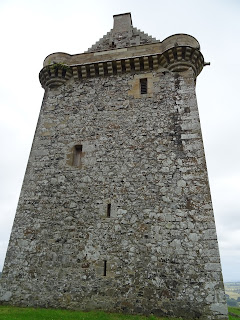Littledean Tower
"A 16th century tower of unique design and of two distinct periods, Littledean stands in a picturesque position above the River Tweed in the Scottish Borders. The earliest building was a typical oblong peel tower.
...
Littledean's defences were augmented by the addition of a substantial and unusual D-shaped tower bristling with gunloops and covering all approaches" (from
scottishcastlesassociation.com)
“The ancient tower of Littledean, on the Tweedside, had long been haunted by the spirit of an old lady, once its mistress, who had been a covetous, grasping woman, and oppressive to the poor. Tradition averred that she had amassed a large sum of money by thrift or extortion, and now could not rest in her grave because of it. Still, in spite of its ghost, Littledean Tower was inhabited by a laird and his family, who found no fault with their place of abode, and were not much troubled by thoughts of the supernatural world. One Saturday evening, however, a servant-girl, who was cleaning shoes in the kitchen by herself, suddenly observed an elf-light shining on the floor. While she gazed on it, it disappeared, and in its place stood an old woman wrapped in a brown cloak, who muttered something about being cold, and asked to warm herself at the fire. The girl readily consented, and seeing that her visitor’s shoes were wet, and her toes peeping out blue and cold from their tips, she good-naturedly offered to dry and clean the shoes, and did so. The old lady, touched by this attention, confessed herself frankly to be the apparition that haunted the house. ‘My gold wud na let me rest,’ said she, ‘but I’ll tell ye where it lies; ’tis ’neath the lowest step o’ the Tower stairs. Take the laird there an’ tell him what I now tell ye; then dig up the treasure, and put it in his hands. An’ tell him to part it in two shares: one share let him keep, for he’s master here now; the other share he maun part again, and gie half to you, for ye are a kind lassie and a true, and half he maun gie to the poor o’ Maxton, the old folk and the fatherless bairns, and them that need it most. Do this and I sail rest in my grave, where I’ve no rested yet, and never will I trouble the house mair till the day o’ doom.’ The girl rubbed her eyes, looked again, and behold the old woman was gone!
Next morning the young servant took her master to the spot which had been indicated to her, and told him what had taken place. The stone was removed, and the treasure discovered, and divided according to the instructions given. The laird, being blessed with a goodly family of sturdy lads and smiling maidens, found no difficulty in disposing of his share. The servant-girl, so richly endowed, found a good husband ere the year had passed. The poor of Maxton for the first time in their lives blessed the old lady of Littledean, and never was the ancient tower troubled again by ghost or apparition.” (from
borderarchaeology.co.uk)
Littedean is a very interesting looking tower but is sadly badly overgrown and is at the end of an overgrown path so you will likely find yourself battling through waist high nettles to even reach it!























































